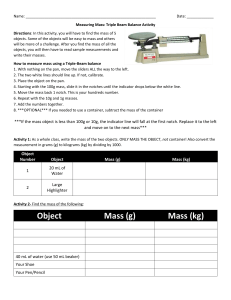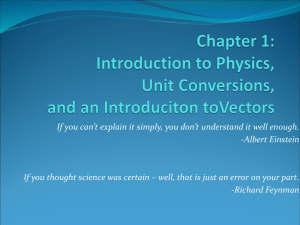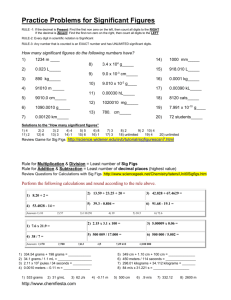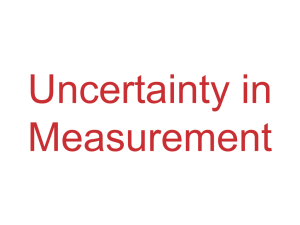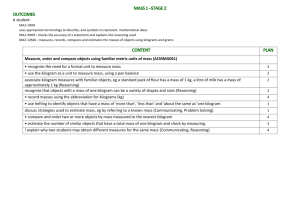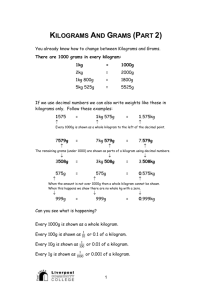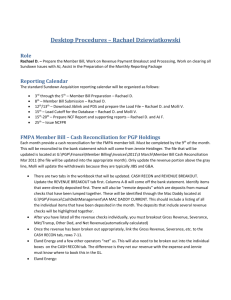Mass
advertisement
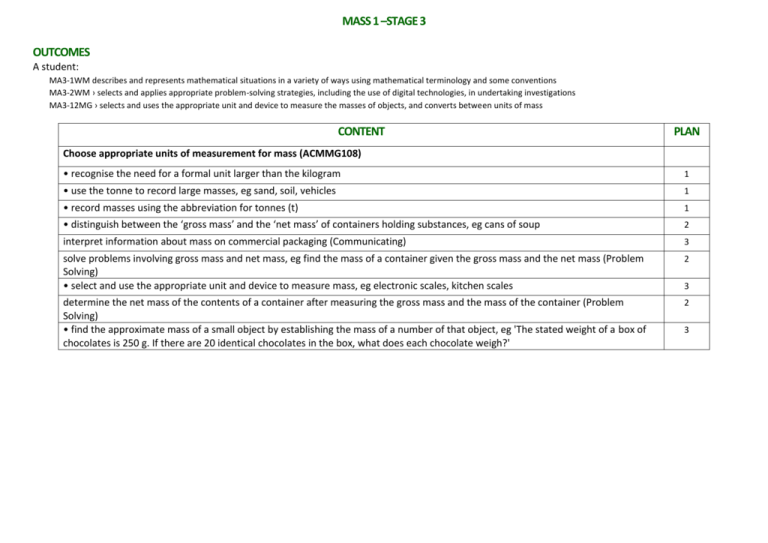
MASS 1 –STAGE 3 OUTCOMES A student: MA3-1WM describes and represents mathematical situations in a variety of ways using mathematical terminology and some conventions MA3-2WM › selects and applies appropriate problem-solving strategies, including the use of digital technologies, in undertaking investigations MA3-12MG › selects and uses the appropriate unit and device to measure the masses of objects, and converts between units of mass CONTENT PLAN Choose appropriate units of measurement for mass (ACMMG108) • recognise the need for a formal unit larger than the kilogram 1 • use the tonne to record large masses, eg sand, soil, vehicles 1 • record masses using the abbreviation for tonnes (t) 1 • distinguish between the ‘gross mass’ and the ‘net mass’ of containers holding substances, eg cans of soup 2 interpret information about mass on commercial packaging (Communicating) 3 solve problems involving gross mass and net mass, eg find the mass of a container given the gross mass and the net mass (Problem Solving) • select and use the appropriate unit and device to measure mass, eg electronic scales, kitchen scales 2 determine the net mass of the contents of a container after measuring the gross mass and the mass of the container (Problem Solving) • find the approximate mass of a small object by establishing the mass of a number of that object, eg 'The stated weight of a box of chocolates is 250 g. If there are 20 identical chocolates in the box, what does each chocolate weigh?' 2 3 3 MASS 2 – STAGE 3 OUTCOMES A student: MA3-1WM describes and represents mathematical situations in a variety of ways using mathematical terminology and some conventions MA3-2WM › selects and applies appropriate problem-solving strategies, including the use of digital technologies, in undertaking investigations MA3-12MG › selects and uses the appropriate unit and device to measure the masses of objects, and converts between units of mass CONTENT PLAN Connect decimal representations to the metric system (ACMMG135) • recognise the equivalence of whole-number and decimal representations of measurements of mass, eg 3 kg 250 g is the same as 3.25 kg • interpret decimal notation for masses, eg 2.08 kg is the same as 2 kilograms and 80 grams 4 • measure mass using scales and record using decimal notation of up to three decimal places, eg 0.875 kg 5 4 Convert between common metric units of mass (ACMMG136) explain and use the relationship between the size of a unit and the number of units needed to assist in determining whether multiplication or division is required when converting between units, eg 'More grams than kilograms will be needed to measure the same mass, and so to convert from kilograms to grams, I need to multiply' (Communicating, Reasoning) • solve problems involving different units of mass, eg find the total mass of three items weighing 50 g, 750 g and 2.5 kg 6 • relate the mass of one litre of water to one kilogram 7 7
